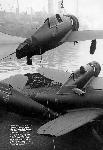Фотографии
-
Republic P-47 Thunderbolts, fresh from the USA, being unloaded from a merchantman in Liverpool Docks in February 1944.
An anonymous P-47 is lowered on to an RAF flatbed truck at Liverpool. The absence of cowling panels on the top of the fuselage behind the engine was clearly deliberate, perhaps to permit regular en-route checks of systems or tankage. Most of the P-47s were stencilled with the words: ‘‘This plane processed with PAR-AL-KETONE”, a corrosion inhibitor applied to protect the aircraft against salt water on its voyage.Самолёты на фотографии: Republic P-47 Thunderbolt - США - 1941
-
Thunderbolt 42-75255 is lifted ashore from the deck of a Liberty Ship in 1944. It went on to serve with the 378th FS at Headcorn. Of the three other P-47Ds awaiting their turn, the one on the left is 42-76116, and on the right is 42-76404. Again, the word ‘‘UGLY’’ is stencilled above the serial on these two aircraft - what did it denote?
Самолёты на фотографии: Republic P-47 Thunderbolt - США - 1941
-
Самолёты на фотографии: North American P-51D Mustang - США - 1944
-
North American P-51D Mustangs stowed below deck await their turn to emerge into the daylight. At the rear on the right is Inglewood, California-built P-51D 44-72381, again with the word “UGLY” prominently stencilled on the rear fuselage. This aircraft went on to serve with the 83rd FS of the 78th FG at Duxford, and saw post-war service with the Swiss Air Force as J-2129.
Самолёты на фотографии: North American P-51D Mustang - США - 1944
-
Many of the photographs are marked on the back with the official stamp of No 30 MU at RAF Sealand, and it appears that they were intended for use as reference material to show the correct stowage procedures for the aircraft. This example shows a close-up of the lashing points for the undercarriage of a deck-stowed P-51D Mustang, with letters added to be cross-referenced against a key.
Самолёты на фотографии: Lockheed P-38 Lightning - США - 1939North American P-51D Mustang - США - 1944
-
Examination of this rather crowded deck scene reveals a Northrop P-61 Black Widow, two P-38 Lightnings and a pair of P-47D Thunderbolts on a superstructure of girders bolted and welded to the decks of the ship - probably a tanker - to allow the aircraft to be transported. What the white-encircled areas on the P-61B in the foreground refer to is unknown without the key which originally accompanied the pictures.
Самолёты на фотографии: Lockheed P-38 Lightning - США - 1939Northrop P-61 Black Widow - США - 1942Republic P-47D-25 / P-47N Thunderbolt - США - 1943
-
A Lockheed P-38L is hoisted off the deck at Liverpool. Lockheed occupied one of the main hangars at Liverpool’s Speke Airport (Douglas occupied another), the hangar being known as the company’s British Reassembly Division. Aircraft would arrive from Garston Docks for reassembly, then be flown to their units.
Самолёты на фотографии: Lockheed P-38 Lightning - США - 1939
-
This photograph of a P-38L (or possibly its photo-reconnaissance variant, the F-5E) aboard ship provides a good view of the extensive superstructure added to the vessel to carry the aircraft on their journey across the Atlantic to the UK, where front-line units eagerly awaited vital reinforcements to continue the war in Europe.
Самолёты на фотографии: Lockheed P-38 Lightning - США - 1939
-
The cockpit of P-38L Lightning 44-26085, photographed in mid-February 1945 by No 30 Maintenance Unit (MU) at Sealand in north-eastern Wales. The P-38L variant was fitted with a pair of turbo-supercharged 1,475 h.p. Allison V-1710 engines and, unusually for a fighter, was fitted with a control yoke instead of the more common control stick.
Самолёты на фотографии: Lockheed P-38 Lightning - США - 1939
-
A close-up showing the anchorage for a P-61B Black Widow’s tailbooms aboard ship. The stencilling identifies this aircraft as 42-39672, which went on to serve with the 422nd Night Fighter Squadron at Eta in, France, in late 1944, with the name Little Audrey. The stencilling also includes the intriguing detail “PROJECT-92973-R" followed by “UGLY” - any clues as to what either of these may refer to would be gratefully received.
Самолёты на фотографии: Northrop P-61 Black Widow - США - 1942
-
Republic P-47D Thunderbolt serial 44-33270 on a freighter at Liverpool docks before its onward journey to its ultimate destination, RAF Kingsnorth in Kent, where it served with the 53rd Fighter Squadron (FS), part of the 36th Fighter Group (FG), from April 1944. Note the word "UGLY” stencilled on the fuselage aft of the cockpit.
Самолёты на фотографии: Republic P-47D-25 / P-47N Thunderbolt - США - 1943
-
An F-5E Lightning, minus its outer wing panels, awaits transport on a trailer to No 30 MU at Sealand in late July 1945. The fairing for the nose-mounted oblique camera is plainly evident, as are the auxiliary fuel tanks fitted beneath the wing centre section. If you have more info on “UGLY”, do let us know!
Самолёты на фотографии: Lockheed F-4 / F-5 - США - 1941
Статьи
- -
- ??? - David Lockspeiser: 1927-2014
- A.Steenbeck - Lowengeschwader's Big Bang
- B.Dunnell - Flying the Pucara
- D.Gordon - Exercise Shiksha: sharpening India's cold war claws
- F.Merriam - "Better to be Born Lucky than Rich..." /Echoes from Dawn Skies/ (3)
- K.Brookes - Merlin Magic at Farnborough
- M.Goodall - Pemberton Billing an the Four-Winged Farrago
- N.Helmo-Larsen - Who needs a pilot?
- P.Davidson - Off the Beaten Track...
- P.Jarrett - Lost & Found
- P.Jarrett - The Ugly Thuth?
- R.Mulder - Capital Gains: Oslo-Fornebu airport 1934-40
- R.Riding - The Aeroplane that Flies Itself
- R.Tisdale, A.Vercamer - Before & After
- W.Thompson - Distant Thunder











